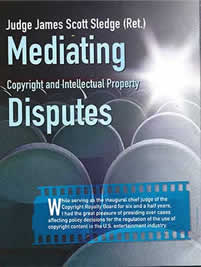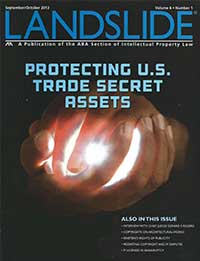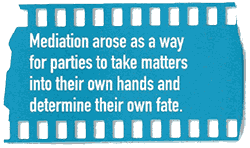Articles in the Media

by Judge James Scott Sledge (Ret.)
Landslide, Sep/Oct 2013
Link to the Article
Judge James Scott Sledge (Ret.)
is an
alternative dispute resolution
professional
with The McCammon
Group, a leading provider of
mediation, arbitration, special
master, and
judge pro tempore
services.
The first chief judge of
the United
States
Copyright
Royalty Board,
he led the
three-
judge court
through
its start
as
the primary, independent
regulatory agency
for copyright
license and royalty
distribution.
He can be reached at
info@mccammongroup.com.

Mediating Copyright and Intellectual Property Disputes
Judge James Scott Sledge (Ret.)
Alabama Mediator Profile
While serving as the inaugural chief judge of the Copyright Royalty Board for six and a half years, I had the great pleasure of presiding over cases affecting policy decisions for the regulation of the use of copyright content in the U.S. entertainment industry.
The entertainment industry, broadly defined, constitutes a major part of the world economy. The creative process embodied in this industry is protected by our U.S. Constitution. This protection is balanced against the need of technology users to benefit society and to expand economic opportunities. (For example, the recent Supreme Court decision in Bowman v. Monsanto Co., dealing with seed patents, will likely impact the balance between creation and use in many areas of technology and research.) In the United States, royalties paid under the statutory licenses exceed $1.5 billion a year, and royalties paid under agreements based on the licenses are many times this amount.
After serving as chief judge, experiencing the dynamics of these copyright disputes, and now having stepped into the world of alternative dispute resolution, I must conclude that the mediation of copyright disputes, and intellectual property disputes generally, offers many advantages over litigation. With the speed of technological advances, the complexities of these disagreements, the need for better outcomes, and the exhaustive cost and slow rate of resolving them in litigation, some other way must be found. Mediation provides an opportunity for better results obtained more quickly, less expensively, privately, and confidentially, as well as in a way that may preserve and enhance critical and ongoing business relationships.
Role of Copyright Royalty Judges
The role of the copyright royalty judges is to decide cases in which disputing parties advocate positions regarding statutory copyright licenses. In so doing, the judges promulgate regulations governing these licenses. (The United States Court of Appeals for the District of Columbia Circuit has alternatively described the judges as a court, a regulatory agency, and a board. The enacting statute refers only to "Copyright Royalty Judges.") These regulations establish royalties and terms for use of copyright content, which in turn govern those users who elect to operate under the licenses. They highly influence all agreements reached for use of copyright content, and thus these regulations play a critical role in the structure and operation of the entertainment industry.
The first six years of the existence of the copyright royalty judges (2006-12) were unusually active, as there was a three-year backlog of cases when the judges were initially appointed in 2006. At the end of the first five years of their work, the judges had completed a full cycle of the statutory licenses and had begun a second one. In this time, the judges addressed all of the statutory licenses at least once, considering many aspects of the broadly defined entertainment industry.
Dramatic Changes in the Entertainment Industry
A common thread found through all the evidence presented in these cases coming before the judges during my tenure as chief judge was the constant and dramatic change occurring in every part of the entertainment industry. Platforms, devices, Internet radio, satellite radio, record labels, movie studios, cable television, sports conferences, and publishing are all in great upheaval; they are frantically searching for paths that lead to a successful future.
Other factors add to this complexity. The competition among the many players is fierce. Public attitudes on piracy, cost, and ownership of and access to content are among the many aspects of this sector that are constantly evolving. The identities of the parties are ever changing by merger, acquisition, reorganization, and otherwise. The relative power among these many parties in the entertainment industry is always in a state of flux.
At the same time, public demands are shifting. In the past, Congress listened mainly to the owners or creators, but now the users of content demand to be heard. Hundreds of billions of dollars a year are at stake in a highly unstable environment. These times are tumultuous indeed.
Factors Impeding the Legal Process
In these circumstances, the legal system cannot keep pace with the needs of businesses, which are under the gun to respond to the increasingly complex advances in technology. Furthermore, the regulations for copyright statutory licenses change only every five or six years, but agreements between parties rarely exceed 18 months because the parties are unable to forecast further than that period of time. Infringement and patent cases can take even longer to resolve. Ironically, by the time a case does make it to the court, generalist judges and juries are ill-equipped to evaluate the complex nature of the changes that have occurred within the industry.
To further complicate matters, the statutory process for the determination of rates and terms of copyright statutory licenses by the judges is very detailed and extensive. The minimum time involved in the disposition of cases pending before the Copyright Royalty Board is 24 months, with a very high volume of discovery and pleadings in the interim. Because the judges and the parties may not tailor the process to fit the specific issues, these limitations greatly increase the cost of litigation.
Additionally, important factors, some of which are described above, are often excluded in the litigation proceedings. The restructuring of business models across various parts of the industry is not considered. The parties do not, and often cannot, present evidence of many of these factors and interests important to their positions on rates and terms because the proceedings are adversarial. As such, they are subject to restrictive procedural and evidentiary rules. A fact finder may receive only a small segment of the facts important to the parties, and is often tasked with rendering good decisions based on a sliver of the pertinent information.
Certainly, the proceedings push the parties into a win-lose paradigm versus a win-win paradigm, and the positions presented by the parties are in the best interest of that party only and not in the best interest of the industry or the public at large.
Business relationships are a casualty of litigation. Intellectual property disputes often arise within small business communities. In the copyright arena, there is much consolidation and streamlining of the industry. Publishers are merging; record labels are consolidating worldwide; Internet radio is moving into large national companies or associations; satellite radio and cable television providers are shrinking; and service providers are consolidating into fewer companies. All of these compete aggressively, but at the same time they have to work together to deliver products and services to the consumer. Unfortunately, relationships are bruised during the attacks and counterattacks of litigation.
Another impediment to the legal process is the limited set of available remedies. Legal remedies are fixed and finite; they may solve the problem or they may not. They are imposed on the parties, rather than adopted by the parties. Legal remedies result in one party winning and one party losing. Compliance may be begrudging, limited, delayed, or even nonexistent.
Disputes often arise as a result of uncertainty about the law and its interpretation. The work of the copyright royalty judges in the first six years (2006-12) afforded the parties the beginnings of stability. From my experience as a federal trial judge (as chief judge of this court and previously as a U.S. bankruptcy judge), my service as chair of the National Conference of Federal Trial Judges, and as chair of the Judicial Division of the American Bar Association, I can state that the inaugural copyright royalty judges were unusually collegial, uniform, and consistent in their decisions. The inaugural judges were unanimous on every decision, except for very limited strategic dissents designed to encourage the United States Court of Appeals for the District of Columbia Circuit to address a specific issue. Indeed, the circuit court affirmed in this early going every substantive decision of the Copyright Royalty Board.
Since June 2012, however, every one of the inaugural judges has left the court. As chief judge, I left before the direct testimony in the satellite radio proceeding began; the economics judge left before the rebuttal testimony began; and the copyright judge left after the determination was issued. This last judge, with decades of copyright experience, stayed longer to afford stability and consistency to the new chief judge and the interim judge. As it turned out, he dissented to the majority decision rendered by the two new judges.
During this same period, Congress initiated hearings regarding proposed changes in copyright law, copyright statutory licenses, and the regulation of those licenses. Indeed, the very structure of the Copyright Royalty Board may be replaced with a new system. Clearly, this is not a period of stability and predictability. This instability is exaggerated when such huge sums of money are involved, and with uncertainty and ambiguities in the regulated industries, creating greater problems in the legal process.
Mediation as an Alternative
Alternative dispute resolution emerged in the 1980s as a proposed answer to public dissatisfaction with the clogged and cumbersome court processes facing disputants. In particular, mediation arose as a way for parties to take matters into their own hands and to determine their own fate.
 Mediation is a negotiation that takes place between disputing parties and is facilitated by a neutral. It provides many potential advantages over litigation as a tool to resolve copyright and intellectual property disputes generally.
Mediation is a negotiation that takes place between disputing parties and is facilitated by a neutral. It provides many potential advantages over litigation as a tool to resolve copyright and intellectual property disputes generally.
The first of these advantages stems from the control parties retain over the process in several vital respects.
The mediation process is controlled by the parties and not by a court. This control permits the parties to address the matters in dispute with the freedom to explore all their interests and concerns. In fact. the parties can modify the actual processes used to fit the nature and details of the dispute at hand. The parties also control the time and location of the mediation; there is no waiting in line and no interruption by a competing demand on the court or by lack of funding for the court.
The process is led by a neutral selected, importantly, by the parties. Through this control, the parties can insure that the neutral has the requisite background to understand the issues on the table. No time is wasted educating a generalist judge or a lay jury about the industry or the factors involved. Likewise, the parties can comfort themselves that the mediator has the requisite neutrality and skill sets to get the job done.
Because the parties maintain control of the process in these various respects, they also maintain control of the outcome. Indeed, the outcome is defined by the eventual agreement crafted by the parties. The parties will always know more about their business and interests than any judge or jury ever could know. The parties are the true "experts" in the complexities of their dispute.
As a result, no "zero verdict" need be imposed on a plaintiff
nor a "runaway verdict" imposed on a defendant. (The
parties can thereby also avoid the risk of an adverse result
becoming an intolerable precedent.) This is the case because
fundamental to the process, the parties must be in agreement
as to a negotiated result. There is at play, implicitly, a risk
analysis that all parties interject into the negotiation, leading to rational, reasonable results, and not draconian ones.
With a skilled, experienced, and knowledgeable neutral
facilitating the negotiations, it is reasonable for the parties
to be optimistic that a settlement will be reached. With
a top-flight neutral, working with sophisticated counsel
and motivated parties, moving the process toward positive
negotiations and away from past firefights, the prospect of
settlement typically falls into the 80 percent range.
Even though this substantial likelihood of resolution exists under these circumstances, each party always has access to a safety switch. Any party can terminate the process at any point and go forward without prejudice in the traditional dispute resolution system: our judicial and administrative process. In this case, the proceedings and substance of the mediation are confidential and thus would have no impact on any ensuing litigation.
 The fact that mediation proceedings are confidential is very
important. This component promotes a level of comfort in the
negotiations among the parties, allowing for more candor and
thus better exchanges of mediation
agreement among all the parties generally prohibits use
of the information in any litigation or other contexts, the parties
are encouraged to "buy in" to the proposition that they are
working together to reach a settlement.
The fact that mediation proceedings are confidential is very
important. This component promotes a level of comfort in the
negotiations among the parties, allowing for more candor and
thus better exchanges of mediation
agreement among all the parties generally prohibits use
of the information in any litigation or other contexts, the parties
are encouraged to "buy in" to the proposition that they are
working together to reach a settlement.
Cost reduction is another advantage to consider with mediation. Copyright and intellectual property disputes are notorious for the length and cost of litigation due to the voluminous and complex facts at play, inevitably implicating the use of experts, giving rise to endless discovery, and eventually leading to trials that seemingly have no end. Patent cases can take years to resolve with a very high number of decisions reversed on appeal and retried. By contrast, because the formalities and time constraints of the legal process are removed in mediation, the resulting cost is a small fraction of that incurred in litigation.
Additionally, the imbedded business costs and distractions of key personnel involved in the mediation of an intellectual property dispute also are a fraction of those incurred in litigation.
Furthermore, the caustic effects of litigation harm business
relations in industries with a small number of players. Entertainment
industries must continuously interact to deliver the goods and services consumers demand. Positive relationships
among them are critical to establishing creative and efficient
services and products. A resolution reached in mediation can
preserve and help build new pathways for these industries to
work together for future success. And, as parties find their own
solutions, the results can be fashioned to improve the position
of all parties, often in global and comprehensive ways. In this
way, a win-win paradigm is possible. It is also true that compliance
with the result reached by agreement (mediation) is
much higher than when the result is imposed on the parties by
a third-party decision maker, as in litigation or arbitration.
An additional advantage of consensual resolutions of intellectual property disputes is favorable reaction by Congress. Members of Congress appreciate parties that come to them with joint proposals, rather than with bickering, name calling, and backstabbing. Results negotiated between disputing parties can be timely, favorably, and comprehensively considered by Congress with a substantial probability that they will be implemented because they benefit all.
Public Goods v. Private Goods
Copyrights, and intellectual property matters generally,
fall into the category of "public goods" rather than "private
goods." This is the case because of their dynamic and
complex integration into our tumultuous and ever-changing
technological and economic environment. This is also true
because these matters generally can be used by essentially
an infinite number of parties. In essence, the universe can
enjoy these "public goods" without limiting their availability
to others.
On the other hand, "private goods" (commercial services and products generally) are limited in their number and nature, and thus as they are used by some, others are deprived.
Our traditional litigation system is more suited to deal with disputes involving "private goods." Calling balls and strikes and declaring winners and losers in respect to limited resources makes much more sense for "private goods" and takes place naturally and traditionally in courts.
"Public goods" may be shared and licensed and are thus better addressed by more flexible and collaborative processes, such as mediation, so the parties can find solutions that fit their own needs, and those of the public as well.
Closing
The litigation of intellectual property cases involves excessive costs and extended time frames, leading to unpredictable results. Fundamentally, the parties are not in control. As public resources, and specifically those of our court system, come under increasing pressures, litigation will provide an even more troubled path going forward.
At the same time, increasing global competition will
cause parties to need more effective and efficient ways to find
reasonable resolutions in intellectual property disputes. Mediation -
with its many advantages- will continue to evolve as
a powerful tool to be utilized by lawyers as they seek to better serve their clients.
Judge James Scott Sledge (Ret.) is an alternative dispute resolution professional with The McCammon Group, a leading provider of mediation, arbitration, special master, and judge pro tempore services. The first chief judge of the United States Copyright Royalty Board, he led the three-judge court through its start as the primary, independent regulatory agency for copyright license and royalty distribution. He can be reached at
info@mccammongroup.com.

